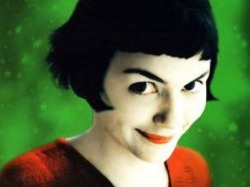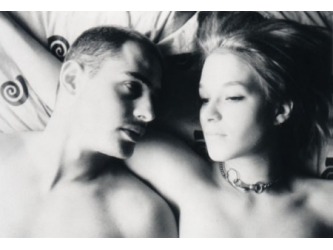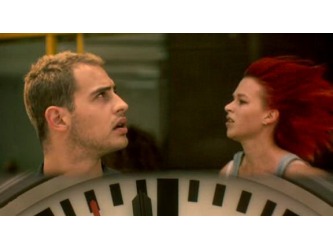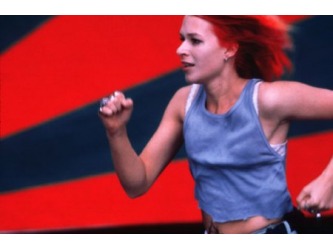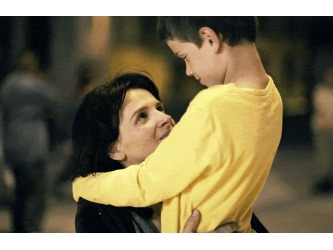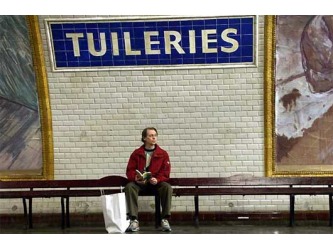Baiting the Viewer to offer the Catch
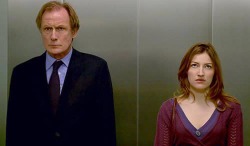
“The Girl in the Café” begins as a delightfully awkward film that the viewer eagerly awaits to evolve into a passion awakening love story. It leaves the viewer no reason to consider it to move beyond this plot as it plays upon the stereotypes of “boy meets girl” with phone calls and rides home. But before the film can satisfy the viewer with a climax to its original story line (being a revelation of feelings or intercourse), it introduces a second plot, one in which “8 men have the potential to really change the world” accompanying the shifting of the plot is a dramatic change in mood. The awkward, light hearted feeling is replaced by a grave and rather serious tone. At times in the second half of the film, the viewer may feel a sense of loss for the plot he was at once so caught up in, but their attention is maintained despite the shift, by bits and pieces of the awkward romance, and a swift sweeping of the new serious matters beginning with riot footage. In the end, the unlikely romance proves to be impossible, but the sense of loss in no way outweighs the sense of tragedy conjured by the tales of the dying in third world countries. The film is a bit of a trap, as it lures viewers in under a false pretense of its actual objective. The strategy is successful, as the emotional connection established through the “boy meets girl” strategy is played upon to gain sympathy and inspire action. The film does a nice job of wrapping up the conflict it so enthusiastically and boldly introduces. The ending quote reinforces the true message. And although the viewer may feel misled, who can argue that any means would be necessary to make such a point?
Salut Cousin! Ciao Success!
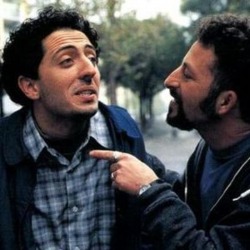
In the film “Salut Cousin”, director Merzak Allouache relays a supposedly comical story of two very different relatives. The film is difficult to comment on because it is difficult to appreciate. As Mok references fables in his rap, this story is similar to the "town mouse country mouse" fable. While there is obviously intended humor in the film, this sly comedy fails to cover completely the deeper, incredibly grave, issues beneath it. Despite the viewer’s presumed knowledge of the gravity of the immigration situation, the film fails to fully convey that sense either.The mood therefore is difficult to pin point It seems that it is caught in the middle similarly to the Algerian immigrants that have no heart acknowledged home.
There are many levels of irony throughout the film. In addition to the fact that this "welcomed asylum" fails to provide a true home, irony is established in the onset of the film as Alilo enters what Mok would consider to be paradise. His outside perspective allows the viewer to determine that it is in fact a slum. Irony is also found as the expectations that the viewer has for the characters is reversed by the ending of the film, in which Mok and Alilo switch places. Prior to that switch there is also irony in the fact that French television is watched in Algeria while Algerian telivision is watched in France. This notion of home continues to emerge throughout the film. On a more societal level, the notion of integration is in actuality segregation. the irony of the plot itself is developed based on the deconstruction of stereotypes.
In addition to its lack of successful commentary, the film lacks dramatic focus. The plot is underdeveloped as the film attempts to accomplish too much at once, rather than creating any clear objective or focus. Although this is ambitious, the combination of all of these elements creates a divide in which the viewer fails to connect with the character. In spite of the film’s lack of dramatic direction and unsuccessful portrayal of a deeper issue, it does serve to raise questions about immigration and misconstrued realities.
There are many levels of irony throughout the film. In addition to the fact that this "welcomed asylum" fails to provide a true home, irony is established in the onset of the film as Alilo enters what Mok would consider to be paradise. His outside perspective allows the viewer to determine that it is in fact a slum. Irony is also found as the expectations that the viewer has for the characters is reversed by the ending of the film, in which Mok and Alilo switch places. Prior to that switch there is also irony in the fact that French television is watched in Algeria while Algerian telivision is watched in France. This notion of home continues to emerge throughout the film. On a more societal level, the notion of integration is in actuality segregation. the irony of the plot itself is developed based on the deconstruction of stereotypes.
In addition to its lack of successful commentary, the film lacks dramatic focus. The plot is underdeveloped as the film attempts to accomplish too much at once, rather than creating any clear objective or focus. Although this is ambitious, the combination of all of these elements creates a divide in which the viewer fails to connect with the character. In spite of the film’s lack of dramatic direction and unsuccessful portrayal of a deeper issue, it does serve to raise questions about immigration and misconstrued realities.
Talk to Her
The film “Talk to Her” is an interestingly crafted narrative that explores bizarre relationships and obsession. The relationships are emphasized by flashing text on the screen reading the names of the two characters involved. Its mood is difficult to identify, as the events within the film are heavy, but the characters treat them lightly.
The irony of the film lies in the fact that much of the action unfolds while two of the main characters are unconscious. An example of this is in Alicia’s pregnancy as well as in the fact that Marco and Lydia break up during her coma. Through the avenue of these comas, the film adopts an interesting use of conversation. It shows that a monologue of one character to another silent character can be just as effective as a two way conversation.
The majority of the shots within the film are slow and fluid. Most of the time the zooming in of the camera is accompanied by music, which helps with characterization. But there remains however a lack of development and large amount of ambiguity surrounding the personality of each character that could perhaps be improved through the omission of some less significant shots within the film and the insertion of more flashbacks or dialogue.
Almost half of the film is made up of slow motion shots with artistic angles and dramatic music. It includes excerpts of entire songs that are irrelevant to the plot itself. Sound is another heavily emphasized component of the film. Each scene contains crucial off screen sound that indicates change or an event. But as important as these sounds, is the silence in the film that accompanies visuals of characters’ gazes or extremely important action. Music is used much in the same way as sound to offer subjectivity or place weight on an event.
Any inkling of artistic or intellectual value that the film possesses is lost during the silent film excerpt. Although it could be taken as a metaphor for Benigno “crawling inside of” Alicia, it is largely inappropriate to the film and distracts the viewer from the action within the story.
In the end of the film, the ballet teacher utters a statement that “nothing is simple.” That is a perfect statement to be used to describe this film. Ironically however, the film seems to simplify the more dramatic aspects of its story. For example, despite the fact that Benigno rapes Alicia, the viewer sympathizes with him and avoids the horror of the situation due to its near mention in passing. The suggestion of the normalcy of this situation is supplemented by Marco’s near assumption of Benigno’s identity and his obsessions. Perhaps it simply relies on the ability of the viewer to perceive contradictions to everyday life in order to establish an ambiguity to this morally black and white world.
The irony of the film lies in the fact that much of the action unfolds while two of the main characters are unconscious. An example of this is in Alicia’s pregnancy as well as in the fact that Marco and Lydia break up during her coma. Through the avenue of these comas, the film adopts an interesting use of conversation. It shows that a monologue of one character to another silent character can be just as effective as a two way conversation.
The majority of the shots within the film are slow and fluid. Most of the time the zooming in of the camera is accompanied by music, which helps with characterization. But there remains however a lack of development and large amount of ambiguity surrounding the personality of each character that could perhaps be improved through the omission of some less significant shots within the film and the insertion of more flashbacks or dialogue.
Almost half of the film is made up of slow motion shots with artistic angles and dramatic music. It includes excerpts of entire songs that are irrelevant to the plot itself. Sound is another heavily emphasized component of the film. Each scene contains crucial off screen sound that indicates change or an event. But as important as these sounds, is the silence in the film that accompanies visuals of characters’ gazes or extremely important action. Music is used much in the same way as sound to offer subjectivity or place weight on an event.
Any inkling of artistic or intellectual value that the film possesses is lost during the silent film excerpt. Although it could be taken as a metaphor for Benigno “crawling inside of” Alicia, it is largely inappropriate to the film and distracts the viewer from the action within the story.
In the end of the film, the ballet teacher utters a statement that “nothing is simple.” That is a perfect statement to be used to describe this film. Ironically however, the film seems to simplify the more dramatic aspects of its story. For example, despite the fact that Benigno rapes Alicia, the viewer sympathizes with him and avoids the horror of the situation due to its near mention in passing. The suggestion of the normalcy of this situation is supplemented by Marco’s near assumption of Benigno’s identity and his obsessions. Perhaps it simply relies on the ability of the viewer to perceive contradictions to everyday life in order to establish an ambiguity to this morally black and white world.
La Haine
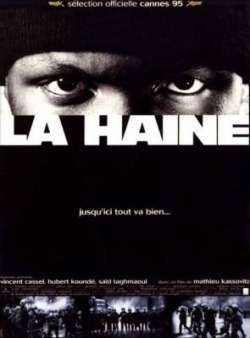
The film “La Heine” uses a few days in the life of three boys to explore the concept of hate and its origins. During the film, one of the boys makes the comment that “hate breeds hate” and this proves to truly be the case as it is passed in the film from one character to another, corrupting both the impressionable young and the morally established.
The film gains credibility for its story as it begins with what appears to be real footage of actual riot scenes. The style of these camera angles and shots is adopted and maintained throughout the film. They are fluid and long. Time flashes on a black screen in between segments of action, revealing the amount of violence that occurs in one day, as well as the length of a second in the last shot.
This credibility is strengthened through the use of sound as lots of background noise and overlapping dialogue eliminates the perception of staging or script. The music in the film is all repeated both in and outside of diegetic constraints. The lyrics of these songs, although sometimes in English, are relevant to the subject of the story and therefore draw the viewer in even more.
The mood of the film is heavy. Even the jokes of the characters are difficult to laugh at because of the gravity of the plot. Part of this weight is established by the symbolism of the gun for hatred, as it is passed from character to character. The viewer questions the notion of revenge that is presented as motivation for violence when it seems to be more related to hatred.
The film is a perfect characterization of the “hard knock life” and at times is difficult to continue viewing because of its saturation with arguments and violence. It is however a useful depiction of this part of France, as well as a warning against hatred and prejudice.
The film gains credibility for its story as it begins with what appears to be real footage of actual riot scenes. The style of these camera angles and shots is adopted and maintained throughout the film. They are fluid and long. Time flashes on a black screen in between segments of action, revealing the amount of violence that occurs in one day, as well as the length of a second in the last shot.
This credibility is strengthened through the use of sound as lots of background noise and overlapping dialogue eliminates the perception of staging or script. The music in the film is all repeated both in and outside of diegetic constraints. The lyrics of these songs, although sometimes in English, are relevant to the subject of the story and therefore draw the viewer in even more.
The mood of the film is heavy. Even the jokes of the characters are difficult to laugh at because of the gravity of the plot. Part of this weight is established by the symbolism of the gun for hatred, as it is passed from character to character. The viewer questions the notion of revenge that is presented as motivation for violence when it seems to be more related to hatred.
The film is a perfect characterization of the “hard knock life” and at times is difficult to continue viewing because of its saturation with arguments and violence. It is however a useful depiction of this part of France, as well as a warning against hatred and prejudice.
Amelie
The film “Amelie” is a dazzling French comedy narrated much in the same way as an episode of “Madeline.” Throughout the film, much weight is placed on the introduction of characters according to quirky irrelevant to story likes and dislikes. This emphasizes the importance of personality and relationships within the film. As Amelie becomes a facilitator for the well being of others, these relationships evolve to form several quirky plots within the main plot. To be so complex, the film’s various parts gel surprisingly well. The main plot, which revolves around Amelie’s discovery of her own romance, is at times a bit slow due to the complexity of the film, but the insertion of other characters and events maintains a fast pace that keeps the viewer’s attention.
The mood of the film is quite light, which is maintained by the overabundant colors as well as the film’s use o f photographs. The diction of the narrator also helps maintain this mood as his comments are obviously too serious for the accompanying action. There is also a sort of psychedelic feel to the film, which is supplemented by the costuming of its main character. Elvis Mitchell describes her perfectly in his New York Times review saying, “She has the innocent vitality of a silent-film star; with her helmet of gorgeous brunet hair…. Mr. Jeunet directs his protagonist so that even when she is a child (played by Flora Guiet), each thought and impulse shines though her skin.” This “shining” to which he refers also promotes the playfulness of the film.
In the end, the film is miraculously able to provide a satisfying conclusion to all of its sub plots as well as the romance of Amelie herself. But dispite its closing, it leaves the viewer longing for more adventures with Ameilie. Because of the lighthearted ease with which he is able to explore sew and romance through the narration of her life.
The mood of the film is quite light, which is maintained by the overabundant colors as well as the film’s use o f photographs. The diction of the narrator also helps maintain this mood as his comments are obviously too serious for the accompanying action. There is also a sort of psychedelic feel to the film, which is supplemented by the costuming of its main character. Elvis Mitchell describes her perfectly in his New York Times review saying, “She has the innocent vitality of a silent-film star; with her helmet of gorgeous brunet hair…. Mr. Jeunet directs his protagonist so that even when she is a child (played by Flora Guiet), each thought and impulse shines though her skin.” This “shining” to which he refers also promotes the playfulness of the film.
In the end, the film is miraculously able to provide a satisfying conclusion to all of its sub plots as well as the romance of Amelie herself. But dispite its closing, it leaves the viewer longing for more adventures with Ameilie. Because of the lighthearted ease with which he is able to explore sew and romance through the narration of her life.
September 11th... Not what you'd expect
In response to the terrorist attacks in New York on September 11th, 2001, there were many attempts to commemorate. In the collection of short films within 9’11’’ one would perhaps expect to find a group of tragic films with large sympathetic sentiments toward the United States, however, these global responses to the event of one nation raise more concern for issues and questions surrounding the event than they offer memorial.
Some segments are more moving than others, some lighter, some heavier.
The lightest film was contributed by an African film maker as it used children to dance around issues of poeverty and conflicts in other parts of the war.
Perhaps the segment with the heaviest mood was the Japenese, which used an example of PTS to illustrate the effect of war on a soldier. Although this particular example had nothing to do with the terrorist attacks, it served to make the statement that “there is no such thing as a holy war.” Although this is a statement with which I wholeheartedly agree, the message is incredibly poignant being as America had recently entered what some would call “the war on Islam”.
The clip with the Bosnian women seems to offer the most sympathy to the United States as it identifies with them while simultaneously asking the viewer to consider global conflict. The somber mood without music utilizes no enhancements, presenting simply the harsh realities it represents. The message stands on its own regardless as the film attempts to create a sense of unity out of human suffering in order to fight injustice
One would not be out of line to question the appropriateness of some of the clips, as some, such as the Cuban film maker, are insensitive (the BBC says it was the most sympathetic to America). Having had years to recuperate and process the tragedy, I was able to receive the film well, however, given that it was produced one year later, I would call it inappropriate. One should not approach this film without having had time to reconcile the event or without an open mind, being conscious that it is more of an artistic allegorical response rather than a commemoration of September 11th,2001.
Some segments are more moving than others, some lighter, some heavier.
The lightest film was contributed by an African film maker as it used children to dance around issues of poeverty and conflicts in other parts of the war.
Perhaps the segment with the heaviest mood was the Japenese, which used an example of PTS to illustrate the effect of war on a soldier. Although this particular example had nothing to do with the terrorist attacks, it served to make the statement that “there is no such thing as a holy war.” Although this is a statement with which I wholeheartedly agree, the message is incredibly poignant being as America had recently entered what some would call “the war on Islam”.
The clip with the Bosnian women seems to offer the most sympathy to the United States as it identifies with them while simultaneously asking the viewer to consider global conflict. The somber mood without music utilizes no enhancements, presenting simply the harsh realities it represents. The message stands on its own regardless as the film attempts to create a sense of unity out of human suffering in order to fight injustice
One would not be out of line to question the appropriateness of some of the clips, as some, such as the Cuban film maker, are insensitive (the BBC says it was the most sympathetic to America). Having had years to recuperate and process the tragedy, I was able to receive the film well, however, given that it was produced one year later, I would call it inappropriate. One should not approach this film without having had time to reconcile the event or without an open mind, being conscious that it is more of an artistic allegorical response rather than a commemoration of September 11th,2001.
I am Everyone I've Been. And Everyone I Meet.
The narration “L’ausperge Espagnol” begins with the voice of a young man, using his experiences to explore the concept of identity. His stops and starts in narration build reliability as they establish a conversation like element. The film begins with a light mood, declaring itself not to be taken too seriously through fast forwarded action and exaggerated sounds in the beginning. Although playful moments surface throughout the film, this mood gradually becomes less light as it gains depth incorporating bits of nostalgia, passion, sadness, and tension. The evolution of mood within the film seems to be accompanied by a maturation of the main character himself.
The focus of the film is the question of identity. This concept is explored mainly in the categories of nationality, growth, and relationships. Cultural nationality is of particular interest in the film as Xavier lives in an apartment with people from all different countries. Wendy’s brother visits in order to deconstruct the credibility of national stereotypes, asking the viewer to identify a person not based on their nationality, but as an individual.
The shots o f the film are structured in a way that allows the viewer to examine the story from several viewpoints. At times things are filmed from a characters point of view but the viewer is only ever able to hear and see the thoughts of Xavier, maintaining the believability of the fact that he is the narrator.
The film has a habit of leaving action out, skipping from scene to scene without real conclusion, or even moving quickly within the same scene as seen when Wendy and her brother move from fighting one second, to hugging in the next shot. Also, the viewer often has limited knowledge. Sometimes the voice on the other end of the telephone is heard and other times it is omitted. In addition to this inconsistent involvement, the film often contradicts what the viewer would expect to see. But although frustrating, this strategy aids the film in establishing complexity and ambiguity to eliminate assumption in identities.
It ends with a beautiful message, suggesting the a man is made up of everything he has been and everyone he meets. The film comes full circle as it ends the way it began, with a personal launch.
The focus of the film is the question of identity. This concept is explored mainly in the categories of nationality, growth, and relationships. Cultural nationality is of particular interest in the film as Xavier lives in an apartment with people from all different countries. Wendy’s brother visits in order to deconstruct the credibility of national stereotypes, asking the viewer to identify a person not based on their nationality, but as an individual.
The shots o f the film are structured in a way that allows the viewer to examine the story from several viewpoints. At times things are filmed from a characters point of view but the viewer is only ever able to hear and see the thoughts of Xavier, maintaining the believability of the fact that he is the narrator.
The film has a habit of leaving action out, skipping from scene to scene without real conclusion, or even moving quickly within the same scene as seen when Wendy and her brother move from fighting one second, to hugging in the next shot. Also, the viewer often has limited knowledge. Sometimes the voice on the other end of the telephone is heard and other times it is omitted. In addition to this inconsistent involvement, the film often contradicts what the viewer would expect to see. But although frustrating, this strategy aids the film in establishing complexity and ambiguity to eliminate assumption in identities.
It ends with a beautiful message, suggesting the a man is made up of everything he has been and everyone he meets. The film comes full circle as it ends the way it began, with a personal launch.
Run LOLA Run!!!
. The film Run Lola Run opens with the sound of a ticking clock accompanied by the visual component of a swinging pendulum. This pairing symbolizes the objective of the film: to cause the viewer to consider that the pendulum of life and death hinges on time. In order to convey this idea, the film explores a twenty minute dilemma 3 separate times, in which a matter of seconds can mean life or death.
The set up of the film introduces a key strategy, which relies heavily upon the ability of the viewer to recognize previously seen characters. The scene shows a crowd in a white space, zooming in on specific faces. The characters are introduced again through photographs with written names, and they are visually introduced with spoken names once again as Lola thinks through options for help in the first scenario. This repetitive over-introduction trains the viewer to pay special attention to each character and the way they impact the story.
The film’s mood of panic and urgency is quickly established as techno music plays loudly as Lola runs. The end of each scenario adopts a change in mood through slower more melodious music. The change in music is accompanied with a change in speed as the film makers use slow motion and fast forward to create contrasts in the action.
Apart from their speed, the shots themselves are crucial to maintaining continuity between the three scenarios. This is the case with the shot of Manni’s back pocket and the gun as we walks towards the store, connecting the first and second scenario in a way that creates suspense. The use of two shots within one screen is also a key strategy of the film to show the action surrounding different characters simultaneously. The flashing photograph method was effective in conveying different outcomes.
The film ended as if the situation with Lola and Manni was resolved. A viewer paying careful attention the way the film demanded would be disappointed with this ending, because he would have noted the fact that the homeless man spent some of the 100,000 marks and would therefore expect the car to turn around and punish Manni. For such a well done film, it is unsatisfactory that this detail was overlooked.
The set up of the film introduces a key strategy, which relies heavily upon the ability of the viewer to recognize previously seen characters. The scene shows a crowd in a white space, zooming in on specific faces. The characters are introduced again through photographs with written names, and they are visually introduced with spoken names once again as Lola thinks through options for help in the first scenario. This repetitive over-introduction trains the viewer to pay special attention to each character and the way they impact the story.
The film’s mood of panic and urgency is quickly established as techno music plays loudly as Lola runs. The end of each scenario adopts a change in mood through slower more melodious music. The change in music is accompanied with a change in speed as the film makers use slow motion and fast forward to create contrasts in the action.
Apart from their speed, the shots themselves are crucial to maintaining continuity between the three scenarios. This is the case with the shot of Manni’s back pocket and the gun as we walks towards the store, connecting the first and second scenario in a way that creates suspense. The use of two shots within one screen is also a key strategy of the film to show the action surrounding different characters simultaneously. The flashing photograph method was effective in conveying different outcomes.
The film ended as if the situation with Lola and Manni was resolved. A viewer paying careful attention the way the film demanded would be disappointed with this ending, because he would have noted the fact that the homeless man spent some of the 100,000 marks and would therefore expect the car to turn around and punish Manni. For such a well done film, it is unsatisfactory that this detail was overlooked.
Beyond Romantic Love

Paris is widely proclaimed to be the city of love, which usually conjures up an image of two lovers kissing beneath the Eiffel tower. The film proves to have more layers than that suggested by its title, “Paris Je T’aime.” It paints a different picture of the “city of love” by exploring the various aspects of love within the city. This new view of Paris and love is crafted through the relaying of several “love stories.” Because each segment has a different story and a different director, the mood changes throughout the film, but one consistent element in the film is the mood of irony because it deconstructs the stereotype of what the viewer expects love in Paris to be like. Despite their differences, the stories are untied by their setting, and many of these stories share common themes.
Each of the segments has a fairly predictable form, but many of the segments share an element of surprise as the viewer is led to believe one thing that is proven to be false in the end, such as in the story in which the blind boy thought his girlfriend broke up with him when she was simply rehearsing for a show. The use of the gaze is also used by many of the directors, which is especially crucial in the subway scene because it serves to offer subjectivity when the main character has no dialogue. Narration is another strategy that many of the directors use, as in the clip with the man who ends his affair. Music is also an essential component in many of the clips as it serves to quickly establish a mood that is difficult to develop in such a brief amount of time.
The film struggles to maintain interest because of the number of stories it presents and how little each one is developed. The viewer has little time to become emotionally involved before a new segment is introduced.
In the end of the film, each of the stories are connected through the main characters within them. By interweaving the stories in the end, the film further establishes credibility to the stories themselves, as well as the suggestion that Paris is full of more than just romantic love.
Each of the segments has a fairly predictable form, but many of the segments share an element of surprise as the viewer is led to believe one thing that is proven to be false in the end, such as in the story in which the blind boy thought his girlfriend broke up with him when she was simply rehearsing for a show. The use of the gaze is also used by many of the directors, which is especially crucial in the subway scene because it serves to offer subjectivity when the main character has no dialogue. Narration is another strategy that many of the directors use, as in the clip with the man who ends his affair. Music is also an essential component in many of the clips as it serves to quickly establish a mood that is difficult to develop in such a brief amount of time.
The film struggles to maintain interest because of the number of stories it presents and how little each one is developed. The viewer has little time to become emotionally involved before a new segment is introduced.
In the end of the film, each of the stories are connected through the main characters within them. By interweaving the stories in the end, the film further establishes credibility to the stories themselves, as well as the suggestion that Paris is full of more than just romantic love.
The Mean is the Message
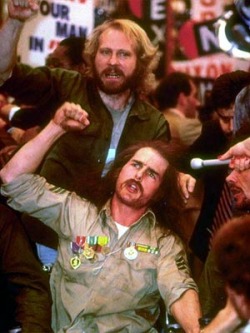
Author Susan Vogel once commented that we are never fully able to appreciate any culture outside of our own origin within our own time. But this notion does not stop film makers from trying to bridge the gap. Although film is in and of itself a distinct type of media, the many means of presentation within it provide several avenues for the exploration of culture. This representation of culture can be seen in the discussion of the Vietnamese within a narrative, a documentary, and an experimental film.
The film “Born on the Fourth of July” is an American made narrative that focuses on many sources of controversy surrounding the Vietnam. The movie itself devotes little time to the actual presentation of the Vietnam culture, as it focuses mainly on the life of an American man. However, the film does comment on the way in which the culture should be viewed. This is shown following the irony of a film in that the man's dream of being a hero was destroyed by his reception as a murderer.This transition changes his mindset of the Vietnamese people a being communist enemies. In one particular scene, he defends the culture to his mother as he rants about the injustice of the war, describing them as his brothers and as people that value freedom. The film, as it the mood transitions from a patriotic pride to a near anarchist disgust , strives to strip the reader of any negative feelings toward the Vietnamese people by projected them onto the American government.
The film “Daughter of Danang” is a documentary film that similarly presents the Western culture as ignorant and selfish. In doing so, it creates an image of the Vietnamese people as a misunderstood culture that deserves a second look. In its discussion of the culture prior to the war, the film reveals that they were taken advantage of as Americans took their children. The film shows many aspects of Vietnamese life including meals and music, but also shows the lack of appreciation on the part of the American. This lack of appreciation is made especially poignant by the way in which the main character contradicts her intentions to embrace her mother and her culture, with actions that reject them. By creating this mood of disgust towards the American people, the film gains sympathy for the Vietnamese.
The film “The scent of green Papaya” is a more artistic and experimental film. Unlike the others, it’s main focus is to depict the Vietnamese culture leading up to the war as a sort of Eulogy. It does so by making the plot subordinate to the images of nature and the sounds of the Vietnam it creates. The heavy concentration placed on these sensual elements asks the viewer to focus more on the culture and the setting than the story itself. It does however use sounds that are not original to the culture, such as airplanes and sirens, to foreshadow the change coming over the country. Through these, as well as the presence of a disagreeable western character, a distinction is created that evokes admiration and appreciation for the old Vietnamese culture.
Although all of the mentioned films have similar points of view in that they ask for the appreciation of Vietnam from the viewer, each has a different objective in doing so. The first, to create a sympathy as a byproduct of the deconstruction of heroic America, the second, to beg for cultural understanding by presenting th oppostie, and the third to attempt to commemorate the Vietnamese culture destroyed by the war.
The film “Born on the Fourth of July” is an American made narrative that focuses on many sources of controversy surrounding the Vietnam. The movie itself devotes little time to the actual presentation of the Vietnam culture, as it focuses mainly on the life of an American man. However, the film does comment on the way in which the culture should be viewed. This is shown following the irony of a film in that the man's dream of being a hero was destroyed by his reception as a murderer.This transition changes his mindset of the Vietnamese people a being communist enemies. In one particular scene, he defends the culture to his mother as he rants about the injustice of the war, describing them as his brothers and as people that value freedom. The film, as it the mood transitions from a patriotic pride to a near anarchist disgust , strives to strip the reader of any negative feelings toward the Vietnamese people by projected them onto the American government.
The film “Daughter of Danang” is a documentary film that similarly presents the Western culture as ignorant and selfish. In doing so, it creates an image of the Vietnamese people as a misunderstood culture that deserves a second look. In its discussion of the culture prior to the war, the film reveals that they were taken advantage of as Americans took their children. The film shows many aspects of Vietnamese life including meals and music, but also shows the lack of appreciation on the part of the American. This lack of appreciation is made especially poignant by the way in which the main character contradicts her intentions to embrace her mother and her culture, with actions that reject them. By creating this mood of disgust towards the American people, the film gains sympathy for the Vietnamese.
The film “The scent of green Papaya” is a more artistic and experimental film. Unlike the others, it’s main focus is to depict the Vietnamese culture leading up to the war as a sort of Eulogy. It does so by making the plot subordinate to the images of nature and the sounds of the Vietnam it creates. The heavy concentration placed on these sensual elements asks the viewer to focus more on the culture and the setting than the story itself. It does however use sounds that are not original to the culture, such as airplanes and sirens, to foreshadow the change coming over the country. Through these, as well as the presence of a disagreeable western character, a distinction is created that evokes admiration and appreciation for the old Vietnamese culture.
Although all of the mentioned films have similar points of view in that they ask for the appreciation of Vietnam from the viewer, each has a different objective in doing so. The first, to create a sympathy as a byproduct of the deconstruction of heroic America, the second, to beg for cultural understanding by presenting th oppostie, and the third to attempt to commemorate the Vietnamese culture destroyed by the war.
The Sound of Silence
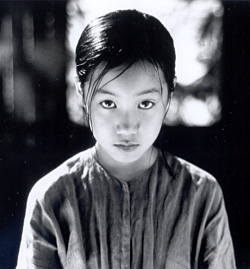
In the film “The Scent of Green Papaya,” director Tran Anh Hung creates an artistic piece rather than one of purely entertainment value by lessening the importance of dialogue. Because of the lack of dialogue due to the artistic nature of the film, sound becomes a crucial contributor to its development.
One way that sound is used is through music that creates subjectivity for certain characters. Many times, this music is paired with the “gaze” of that character. The gaze of the young boy is revealed to be full of mischief through the high pitched, plucking, fast paced music. After its initial introduction, this score is used to note the presence of the boy even when he is not on screen. This tactic is also used to characterize the curious gaze of Mui and the longing gaze of the mistress as she watches Mui while she sleeps.
Another way that Tran keeps the viewer involved in the film is through the interplay of non diagetic and diagetic music. The sitar music in the set up of the film plays behind the visual elements of the story for a good while before it is shown to be coming from a sitar played by the father. Also, the ominous non rhythmic music that plays throughout so much of the film is revealed later in the film to have come from the piano of Khuyen. In contrast to this lack of rhythm, the high timbred consistent beating of the grandmother’s prayer drum characterizes her as steady and traditional. This trend in which non diagetic music is woven into action as diagetic music saturates the film and keeps the viewer invested in the film.
Apart from music, the exaggeration of sound effects in the film is used to direct the viewer’s attention to certain things. Largely this strategy is used to cause the viewer to pay special attention to elements of nature. For example as Mui watches an ant, the viewer can hear its footsteps. This enhances the visually aesthetic aspect of the film creates in the viewer a keen sense of awareness to optimize appreciation. The chirping of crickets and the songs of birds are also exaggerated as they are often louder within the home than outside of it. However, their sound also heightens the viewer’s sensitivity and attention. Besides in the nearly still shots of nature, this tactic is also used in visual action of characters. For example, as the mistress hands a servant some money, although the camera is a good distance away the clinking sound of the coins can be heard. In one instance the viewer’s attention is directed to Mui in the background of some
Tran also uses sound to indicate the time or the occurrence of an event. The sounding of the gong represents the end of the grandmother’s prayer time and in doing so serves to move the servants about their work. The sound of the siren represents the curfew in the town and therefore indicates that it is evening. This siren sound is later imitated by strings to symbolize bondage within the home during times of stress for the characters. Apart from the siren, the sound of planes overhead also serves to show the time period in Vietnam.
Regardless of the strategy, the use of sound throughout the film heightens the image and increases artistic appreciation, while also making up for dialogue in plot propulsion.
One way that sound is used is through music that creates subjectivity for certain characters. Many times, this music is paired with the “gaze” of that character. The gaze of the young boy is revealed to be full of mischief through the high pitched, plucking, fast paced music. After its initial introduction, this score is used to note the presence of the boy even when he is not on screen. This tactic is also used to characterize the curious gaze of Mui and the longing gaze of the mistress as she watches Mui while she sleeps.
Another way that Tran keeps the viewer involved in the film is through the interplay of non diagetic and diagetic music. The sitar music in the set up of the film plays behind the visual elements of the story for a good while before it is shown to be coming from a sitar played by the father. Also, the ominous non rhythmic music that plays throughout so much of the film is revealed later in the film to have come from the piano of Khuyen. In contrast to this lack of rhythm, the high timbred consistent beating of the grandmother’s prayer drum characterizes her as steady and traditional. This trend in which non diagetic music is woven into action as diagetic music saturates the film and keeps the viewer invested in the film.
Apart from music, the exaggeration of sound effects in the film is used to direct the viewer’s attention to certain things. Largely this strategy is used to cause the viewer to pay special attention to elements of nature. For example as Mui watches an ant, the viewer can hear its footsteps. This enhances the visually aesthetic aspect of the film creates in the viewer a keen sense of awareness to optimize appreciation. The chirping of crickets and the songs of birds are also exaggerated as they are often louder within the home than outside of it. However, their sound also heightens the viewer’s sensitivity and attention. Besides in the nearly still shots of nature, this tactic is also used in visual action of characters. For example, as the mistress hands a servant some money, although the camera is a good distance away the clinking sound of the coins can be heard. In one instance the viewer’s attention is directed to Mui in the background of some
Tran also uses sound to indicate the time or the occurrence of an event. The sounding of the gong represents the end of the grandmother’s prayer time and in doing so serves to move the servants about their work. The sound of the siren represents the curfew in the town and therefore indicates that it is evening. This siren sound is later imitated by strings to symbolize bondage within the home during times of stress for the characters. Apart from the siren, the sound of planes overhead also serves to show the time period in Vietnam.
Regardless of the strategy, the use of sound throughout the film heightens the image and increases artistic appreciation, while also making up for dialogue in plot propulsion.
Seek to Understand vs. to be Understood
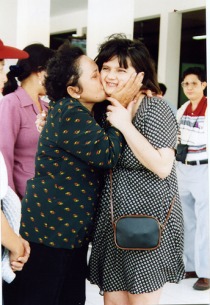
The documentary film “Daughter of Danang” begins by providing the viewer with the notion that it will simply tell the story of an adopted woman’s reunification with her mother. The use of music greatly suggests a dual identity within Heidi as the sitar that plays over the discussion of Vietnam and the acoustic guitar that plays over the discussion of Tennessee overlap during her testimony. This association of sound suggests her ability to identify with both cultures. But the film, as it unfolds, provides eye- brow raising footage of a cultural clash that contradicts this notion. The collision is made distinct and poignant through the way the film utilizes a drastic change in mood. The majority of the film maintains a mood that is hopeful and cheerful, full of joyful fulfillment. This mood is constructed deliberately through testimony to sharpen the shock of its evolution into annoyance and regret demonstrated through real action. This contrast between the changes in mood is strengthened through the difference in the presentation of events. The climactic scene in which the family asks Heidi to help take care of her mother is distinguished by its length as well as its lack of voice over, which creates a contrast with the rest of the documentary. Clearly demonstrated through the speech of her family is the objective of the film to communicate an inability to understand other cultures without will.
Accompanying this cultural commentary is the suggestion that the attempt to understand should accompany the desire to be understood when approaching another culture. This concept is even made applicable to everyday life within one’s own culture as Heidi’s husband alludes to her selfishness in a final interview. The film really causes the viewer to examine themselves and avoid that selfish behavior. Considering that the events of the film were completely unpredictable, the film makers did a fantastic job of capturing and arranging the surprising dramatic action in a way that could be examined and dissected. It was extremely well done in the sense that it conveyed its message about the need to understand other cultures and abandon an element of self to appreciate and accommodate others.
Accompanying this cultural commentary is the suggestion that the attempt to understand should accompany the desire to be understood when approaching another culture. This concept is even made applicable to everyday life within one’s own culture as Heidi’s husband alludes to her selfishness in a final interview. The film really causes the viewer to examine themselves and avoid that selfish behavior. Considering that the events of the film were completely unpredictable, the film makers did a fantastic job of capturing and arranging the surprising dramatic action in a way that could be examined and dissected. It was extremely well done in the sense that it conveyed its message about the need to understand other cultures and abandon an element of self to appreciate and accommodate others.
Truth and Deception; Historical Fact and Fiction
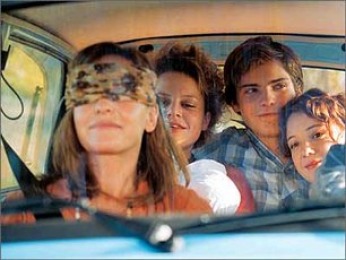
The 2003 narration Good Bye Lenin presents an interesting relationship between historical facts and fiction. Although the film is not based on actual events, the film makers establish the credibility of the story be interweaving it with history through apparent television footage, the offering of specific dates, and the denotation of time passage through text on the screen. The film also utilizes hospital records and footage that looks like a home video in order to solidify the events of the story.
The initial use of this type of crackly screen establishes a sort of nostalgia that is carried throughout the film. Apart from nostalgia, the mood of the film is difficult to characterize as it jumps very quickly from playful to quite somber. Tragedy is always quickly followed by deliberate comic relief. The comedy of the film is a not easy to appreciate because the events of the film are very serious and grave. Music is essential the viewer’s understanding as to what he should be feeling.
The use of time is critical to the strategy of this film. Many events are fast forwarded, especially the arrival of vehicles, which seems to distance the viewer from reality in order to maintain his ability to appreciate the humor of the film. The film also uses special effects such as the shine on the television satellites as an outlet for the viewer to escape grave reality.
The objective of the film is to explore the difference between truth and deception as well as the difference between realism and idealism. Ironically, the boy struggles to establish a false reality for the benefit of his mother only to realize that she had deceived him his entire life. The question arises, largely as a result of Lara’s character, as to whether truth and honesty are always the best policy, or deception can be good when used in the best interest of someone else. The question also arises as to whether the motivation of the manipulation of truth is for self deception or the deception of another. The film was well done, and although fast paced, it would benefit from a cut in length.
The initial use of this type of crackly screen establishes a sort of nostalgia that is carried throughout the film. Apart from nostalgia, the mood of the film is difficult to characterize as it jumps very quickly from playful to quite somber. Tragedy is always quickly followed by deliberate comic relief. The comedy of the film is a not easy to appreciate because the events of the film are very serious and grave. Music is essential the viewer’s understanding as to what he should be feeling.
The use of time is critical to the strategy of this film. Many events are fast forwarded, especially the arrival of vehicles, which seems to distance the viewer from reality in order to maintain his ability to appreciate the humor of the film. The film also uses special effects such as the shine on the television satellites as an outlet for the viewer to escape grave reality.
The objective of the film is to explore the difference between truth and deception as well as the difference between realism and idealism. Ironically, the boy struggles to establish a false reality for the benefit of his mother only to realize that she had deceived him his entire life. The question arises, largely as a result of Lara’s character, as to whether truth and honesty are always the best policy, or deception can be good when used in the best interest of someone else. The question also arises as to whether the motivation of the manipulation of truth is for self deception or the deception of another. The film was well done, and although fast paced, it would benefit from a cut in length.
Beyond Good and Evil: Moral Ambiguity in the Lives of Others

The 2006 German fictional multi-leveled narrative “The Lives of Others” relays an enthralling tale of the GDR’s investigation of an artist couple in 1984 East Germany.
The mood of the film is appropriately somber and suspenseful as it is fairly intense throughout in order to characterize the intensity of the plot it presents. The film combines a plot pattern of investigation and changes in knowledge as it focuses on the moral struggle of one man. Knowledge is critical as the whole concept of the film is based on a desire to “know everything.” In many cases within the film the knowledge of a character determines life or death. For example, had Christa known that Weisel moved the type writer she probably would not have killed herself. An interesting aspect of the film however lies in the fact that the viewer’s knowledge fluctuates between knowing more and less than the characters, therefore achieving suspense while maintaining mystery. Essential to the notion of knowledge the film is the idea of the potential for accurate perception based on one's personal position and understanding of other characters and events.
A key component driving the plot and objective of this film is time. The set up of the film reveals the importance of time as it utilizes the interplay of a past event and the present playing of its recording. This notion continues throughout as missing pieces are filled with writings, conversations, or reports. This use of "recorded audio" also proves to be an important tool to the "perspective" concept mentioned before. This is shown as Weisel listens to a conversation through headphones that the viewer must consider the conversation as it is as well as from Weisler's perspective. The use of time in the form of music is also used masterfully as it offers the audience a form of mental subjectivity. For example, the moral ambiguity of the character Weisel is made clear as an ominous staccato cello score consistently accompanies his rigid and heartless GDR evil side. Without this music, it would be less clear to the viewer exactly what is occurring based on the lack of understanding as to the feelings of Weisel. Music is also used to characterize the change within him as he becomes absorbed and enthralled by the life of Georg as it becomes softer and more melodious.
The main objectives of this film are to explore the concept of the loss of hope demonstrated by suicide as well as to explore the ability of man to change and the concept of goodness. Through dialogue it is proposed early in the film that change is impossible. This notion is contradicted by the film as Weisel clearly changes and Christa’s “good” character becomes more ambiguous. Although the film was long and the plot was often slow, the pace was deliberate as it symbolized the length of the time of the Berlin Wall. It was absolutely captivating and extremely well done, as it considered the mind of the viewer and devoted special attention to detail to ensure understanding of its underlying messages.
The mood of the film is appropriately somber and suspenseful as it is fairly intense throughout in order to characterize the intensity of the plot it presents. The film combines a plot pattern of investigation and changes in knowledge as it focuses on the moral struggle of one man. Knowledge is critical as the whole concept of the film is based on a desire to “know everything.” In many cases within the film the knowledge of a character determines life or death. For example, had Christa known that Weisel moved the type writer she probably would not have killed herself. An interesting aspect of the film however lies in the fact that the viewer’s knowledge fluctuates between knowing more and less than the characters, therefore achieving suspense while maintaining mystery. Essential to the notion of knowledge the film is the idea of the potential for accurate perception based on one's personal position and understanding of other characters and events.
A key component driving the plot and objective of this film is time. The set up of the film reveals the importance of time as it utilizes the interplay of a past event and the present playing of its recording. This notion continues throughout as missing pieces are filled with writings, conversations, or reports. This use of "recorded audio" also proves to be an important tool to the "perspective" concept mentioned before. This is shown as Weisel listens to a conversation through headphones that the viewer must consider the conversation as it is as well as from Weisler's perspective. The use of time in the form of music is also used masterfully as it offers the audience a form of mental subjectivity. For example, the moral ambiguity of the character Weisel is made clear as an ominous staccato cello score consistently accompanies his rigid and heartless GDR evil side. Without this music, it would be less clear to the viewer exactly what is occurring based on the lack of understanding as to the feelings of Weisel. Music is also used to characterize the change within him as he becomes absorbed and enthralled by the life of Georg as it becomes softer and more melodious.
The main objectives of this film are to explore the concept of the loss of hope demonstrated by suicide as well as to explore the ability of man to change and the concept of goodness. Through dialogue it is proposed early in the film that change is impossible. This notion is contradicted by the film as Weisel clearly changes and Christa’s “good” character becomes more ambiguous. Although the film was long and the plot was often slow, the pace was deliberate as it symbolized the length of the time of the Berlin Wall. It was absolutely captivating and extremely well done, as it considered the mind of the viewer and devoted special attention to detail to ensure understanding of its underlying messages.
The Gleaners and I
The Gleaners and I is a documentary by Agnes Varda from the year 2000, that is a combination of a direct cinema and a more moderate form of a portrait documentary. This categorization is due to the way in which the film mixes interviews, personal interjections, and roughly shot material. But in this case the two methods fail to complement each other. Varda does a nice job of creating distinguishable categories of gleaning. However, much of the film seems irrelevant to other its other parts. The interviews in which the subject matter is gleaning greatly contribute to the understanding of the topic, but the testimonies involving more personal stories seem out of place. Similarly out of place was the film maker’s self insertion. Although the film was structured in a way that was purposed to follow her “journey” to examine the art of gleaning, moments such as her “self portrait” or “the dance of the lens cap” or when she tries to “capture” trucks with her hand seem to detract from the goal of the film to topically present the practice of gleaning. The journey concept is also poorly constructed as the pronoun “we” is introduced with no preceding antecedent.
The objective of the film maker seems to be larger than to simply convey information about the practice of gleaning, which could serve to defend her attempt to mesh many seemingly irrelevant pieces of information. But this larger theme seems to attempt to accomplish too much. In essence, it simply distracts from the determination of the purpose of the film, due to its lack of focus. Also questionable is the fact that the woman frames the documentary to suggest that it is being filmed with a small digital camera that she purchased, but there are shots of her with the camera that are logically impossible according to that assertion. Her mood however is not lost, as she maintains a feeling of nostalgia for youth and the positive elements of the past.
The objective of the film maker seems to be larger than to simply convey information about the practice of gleaning, which could serve to defend her attempt to mesh many seemingly irrelevant pieces of information. But this larger theme seems to attempt to accomplish too much. In essence, it simply distracts from the determination of the purpose of the film, due to its lack of focus. Also questionable is the fact that the woman frames the documentary to suggest that it is being filmed with a small digital camera that she purchased, but there are shots of her with the camera that are logically impossible according to that assertion. Her mood however is not lost, as she maintains a feeling of nostalgia for youth and the positive elements of the past.
Buena Vista Social Club
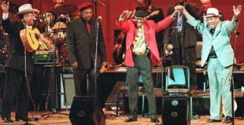
This award winning documentary tells the story of the coming together of several forgotten musical legends from Cuba. The vision of one man brings them together to create an album together. As shown by its long musical introduction, the documentary devotes great attention to the music itself by including long clips of just music. This music is shown being performed in the studio, in homes, on the streets, as well as on the stage. The film devotes an equal amount of attention to the musicians themselves. Intimate character profiles are created as each man within this band tells his story. Even that which does not include music itself is included. The film conveys a strong relationship between the individual and his music as well as his culture. The culture of the musicians is manifested in their visit to the United States by their actions and the expressions on their faces as they walk the city streets. Their visit is prompted by the desire of Ry, the creator of the band, to have a concert for the band because of the growing popularity of their album, and the musical scenes from the concert are incredible. The use of a surrounding shot is common within this film and it almost characterizes the strategy of the documentary as whole to create an all encompassing picture of these musicians.
The Corporation
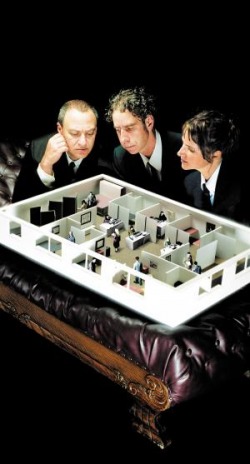
This documentary serves as a social commentary on the lack of public control over big corporations. The film describes the way in which a corporation is considered an individual and then cleverly asserts corporations to be people without “moral conscience” who therefore bear no “moral responsibility.” As the film explores the corporation’s harm to workers, health, animals, and the biosphere it creates a visual “checklist” that eventually is used to diagnose corporations as psychopaths.
The film utilizes the voice of a narrator, but the majority of its information is relayed through a series of interviews. Audio and visual elements serve to supplement the argument as music and images appear during speaking in order to emphasize certain words. The interviewees include the perspectives of CEOs and rivals of corporations but the siding is made quite evident. Apart from the interviews, various metaphors and analogies are offered with visual aids to ensure understanding. The film is on the longer side of a typical documentary, but includes a large amount of personal testimonies, stories, and specific examples of exploitation. The last portion of the film issues a strong and direct call for action revealing that beyond informing, this documentary was purposed to inspire individuals to act as catalysts for change..
The film utilizes the voice of a narrator, but the majority of its information is relayed through a series of interviews. Audio and visual elements serve to supplement the argument as music and images appear during speaking in order to emphasize certain words. The interviewees include the perspectives of CEOs and rivals of corporations but the siding is made quite evident. Apart from the interviews, various metaphors and analogies are offered with visual aids to ensure understanding. The film is on the longer side of a typical documentary, but includes a large amount of personal testimonies, stories, and specific examples of exploitation. The last portion of the film issues a strong and direct call for action revealing that beyond informing, this documentary was purposed to inspire individuals to act as catalysts for change..
The Brothers Lumiere
This film, narrated by Bertrand Tavernier, strategically presents several of the Lumière brothers’ films in order to create a general overview of their work. This overview forms a foundation which enables the construction of basic characterization, commentary, and analysis of those films. The film opens with the voice of Tavernier accompanied by a series of still photographs as he sets the stage for the evolution of film. As his description of the invention of the moving camera by the Lumière brothers begins, short clips of their first endeavors replace the still photographs as the visual accompaniment.
As each film begins, Tavernier introduces it by name and describes the setting and situation. He then proceeds to comment on the developmental and artistic aspects of each frame. These comments are largely made up of praises for angles, perspective, and levels, but do include some criticism. The narration explores the well roundedness of the filmmakers as it speaks to their desire to film on every continent as well as to film a broad range of subjects. Within and in between the descriptions are comical asides and personal interjections, which contribute to the presentation of the Lumière brothers as young and funny. The film comments on the development of the brothers but ends by alluding to their contribution to the future of film making.
As each film begins, Tavernier introduces it by name and describes the setting and situation. He then proceeds to comment on the developmental and artistic aspects of each frame. These comments are largely made up of praises for angles, perspective, and levels, but do include some criticism. The narration explores the well roundedness of the filmmakers as it speaks to their desire to film on every continent as well as to film a broad range of subjects. Within and in between the descriptions are comical asides and personal interjections, which contribute to the presentation of the Lumière brothers as young and funny. The film comments on the development of the brothers but ends by alluding to their contribution to the future of film making.
